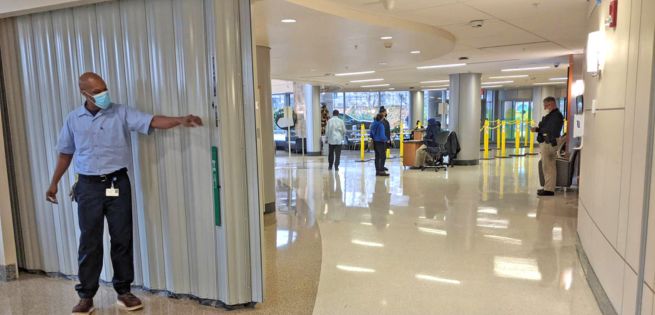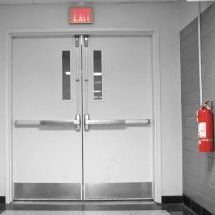What Facility Managers Must Know for Fire Prevention Week 2025
October 02, 2025
Fire Doors: The Silent Heroes of Fire Prevention Week 2025
You probably don’t think about fire doors often. That’s okay—most people don’t.
Until they need one.
Every October, Fire Prevention Week reminds us to test the smoke detector, review evacuation plans, and clear out the old batteries from the emergency kit. But this year, Door Services Corporation wants to put the spotlight on a building feature that’s often ignored until it’s too late: the fire door assembly.
From October 5–11, 2025, facility managers across Canada and the U.S. have a chance to look at fire safety through a new lens—one that doesn’t flash or beep, but quietly protects building occupants every single day.
A Week Worth Your Attention
Fire Prevention Week started in the 1920s. It’s been around longer than duct tape, and even the modern fire alarm. It exists for one reason: to prevent fire-related emergencies.
Modern fire protection isn’t only about reacting fast. It’s about building smarter, putting systems in place that allow safe escape routes and contain fire exposure. That’s exactly what a fire rated door is designed for.

Why Fire Doors Get Overlooked (And Why That’s a Problem)
Fire rated doors don’t call for attention. They don’t typically blink or buzz or show up on a touchscreen dashboard. But they are required in critical areas of most commercial buildings—stairwells, corridors, and fire exits.
When working properly, these opening protectives slow the spread of smoke and flames, giving people time to leave and emergency crews time to respond.
But when fire door assemblies are wedged open, damaged, or unlatched—those extra minutes disappear.
That’s why annual fire door inspections are not just a suggestion. They are a clear inspection requirement supported by national standards.
“It Looked Fine…”
We hear this often. Facility teams assume a door is compliant because it looks intact. But compliance isn’t about appearances. If a door has the wrong door closers, missing label, or a warped door frame—even slightly—it no longer carries the correct fire door rating.
And here’s the reality: many rated doors have been non-compliant for months, or even years, before anyone realizes.
Inspections Aren’t Just Red Tape
The National Fire Protection Association (NFPA 80) requires annual inspection requirements for all fire door assemblies. Even the best equipment changes over time: hinges loosen, smoke seals wear down, and doors swell with moisture.
Our technicians have walked into sites where a multi-million-dollar property failed inspection because someone had used the wrong screws in fire door hardware. Small detail. Big consequences.
Here’s What You Can Do Right Now
If you’re a facility manager, Fire Prevention Week is the perfect time to take three simple steps:
Schedule a Fire Door Inspection
Our team at Door Services Corporation will perform a complete inspection process, check your fire rated openings, and document results for your records. If something fails, we’ll explain the repair and fix it fast.
Revisit the Paper Trail
Can you find last year’s inspection report? A missing report may not seem serious until the fire marshal asks during a review of code compliance.
Talk to Your Team
Most failures aren’t from wear and tear. They happen because someone props open smoke doors or blocks a door opening. Training staff to follow fire door requirements makes a real difference.
Real Problems, Real Fixes
Consider a transit hub where one exterior door hasn't latched in years. People assume it is just stiff. In reality, water damage has warped the door assembly, and it no longer meets fire door inspection requirements. A quick repair can restore compliance and safety.
That’s the type of low-cost, high-impact fix that comes from proper fire door inspections.

Don’t Know Where to Start? We’ve Got You.
If you’re not sure what to look for—or whether your fire rated doors are compliant—our Fire Door Inspection Guide has detailed information, checklists, and real examples. It covers fire tests, fire door rating requirements, and practical tips to keep your facility safe.
Bottom Line: Fire Doors Work—If You Let Them
 Fire Prevention Week only comes once a year, but the purpose is the same: protect lives, reduce harm, and encourage stronger systems.
Fire Prevention Week only comes once a year, but the purpose is the same: protect lives, reduce harm, and encourage stronger systems.If your facility has commercial doors with a fire rating—and you’re not certain they pass inspection—now’s the time to act. You don’t need a crisis to take fire door inspections seriously. You just need a calendar reminder and the right partner.
That’s us.
Visit the Fire Door Inspection Guide
Frequently Asked Questions
1. Why are fire door inspections important?Because fire door assemblies must provide proper fire resistance and function as intended in an emergency.
2. How often do fire doors need to be inspected?
Per NFPA 80, fire door inspections are required at least once per year in accordance with the standard.
3. What is included in a fire door inspection?
Checks include the label, fire door hardware, closing function, clearance, and any visible damage.
4. What happens if a fire door fails inspection?
The issue must be corrected with approved parts or adjustments. Non-compliant fire rated openings may increase liability.
5. Where can I learn more about fire door compliance?
See our free Fire Door Inspection Guide.
